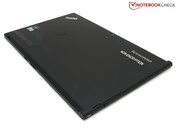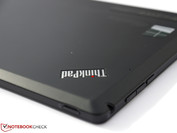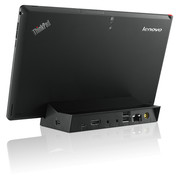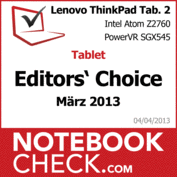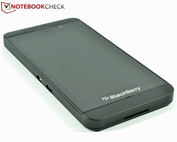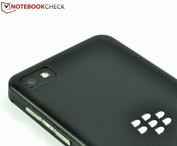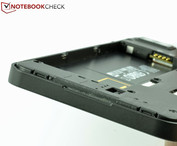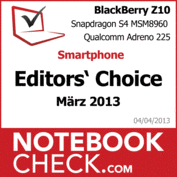Notebookcheck's Best of March 2013 - Smartphone and Tablet Edition
We have tested 14 Smartphones and tablets in total in March, which is a new record for the Ultra-mobile sector at notebookcheck.com. With eight models, the tablets have a more favorable representation in terms of numbers, whereas the Smartphones can offer a few more highlights with the Sony Xperia Z and the BlackBerry Z10. This is in contrast to the tablet world, where primarily entry and middle-class devices are trying to win customers over. But one step at a time.
Out of eight tablets, six are equipped with ARM processors. In addition to those six, there are two representatives from the x86 group, one of which has a massive 20-inch screen. In March, there are both reputable brand manufacturers, as well as budget devices. The Captiva PAD 8 Pro represents a new contender in the latter category. The Xoro PAD 9718DR, the Pearl Touchlet x10.Dual+ and the Archos 80 Titanium, are also aiming in the same direction. Asus is even represented with two devices in March. While the smaller 7-inch Asus Memo Pad ME172V is clearly targeted towards beginners, the larger 10-inch brother Asus Memo Pad Smart 10 ME301T is aiming to compete in the middle-class segment and generate consumer interest with its fair price. With its Intel Atom CPU, Lenovo ThinkPad Tablet 2 Wi-Fi allows for the installation of any Windows software, which broadens application possibilities of a tablet immensely. The same applies to the Sony Vaio Tap 20 SVJ2021V1E, which even accommodates a Core i5 - and a 20-inch display. For that reason, the tablet giant costs over 1000 Euros (~$1304).
In the Smartphone world in March, the fight was called Blackberry and Sony against the rest of the world. While the Canadians and the Japanese have presented a new flagship each, the established competition was somewhat more reserved. Still, there were a number of exciting products. Beside the two already mentioned - Blackberry Z10 and Sony Xperia Z - Huawei has also sent two interesting Android devices, namely the Ascend G600 and Ascend G615. We are eagerly awaiting the second device with Intel technology, the ZTE Grand X IN. And last but not least, the Nokia Lumia 620 Windows 8 Phone is on the starting blocks.
Category Tablets
Challengers:
Xoro PAD 9718DR 79%
Lenovo ThinkPad Tablet 2 Wi-Fi 86%
Asus Memo Pad Smart 10 ME301T 83%
Sony Vaio Tap 20 SVJ2021V1E 74%
The Captiva PAD 8 Pro is the second device of the Bavarians, which has found its way into our test laboratory. The 8-inch device convinced us with interesting features, such as two cameras, which is unusual for this size format, and good performance. It makes the demanded price of 159 Euros (~$207) seem like a real bargain. However, the purchase would also come with a few weaknesses. Even though Captiva implements an IPS panel, it does not have high brightness. The quality of the pictures taken is poor and the battery life is very poor. However, the tablet can still be interesting for beginners due to the low price and the number of accessories supplied by the manufacturer. However, this is not enough for Captiva to win the "Tablet of the Month" award this time.
Xoro is obviously targeting Apple’s iPad with its PAD 9718DR - at least it uses the popularity of the Cupertino tablet to advertise its own product. The Xoro PAD 9718DR possesses nearly the same dimensions and looks very similar to the iPad. In addition, the display offers the same resolution as the Apple Retina. And as if that was not already enough, Xoro even uses the same marketing term as Apple, i.e. calling it Retina. However, there are various reasons why it is still not enough to be a serious competitor for the iPad. It is not because of the display resolution. Neither is it the manufacturing and haptics. However, the brightness of the display is weak and the fact that a reboot is required when changing the resolution is fairly annoying. However, this is actually necessary, as some applications do not support such a high resolution. And the performance in HD mode is significantly lower. In addition, there are poor cameras and a non-existent GPS sensor. The bottom line is that the Xoro PAD 9718DR is only another tablet among many others.
After Acer, another self-nominated premium manufacturer has dared to step into the low budget segment. The Asus Memo Pad ME172V at 149 Euros (~$194) is both the cheapest tablet of the Taiwanese manufacturer and an entry into the new tablet range called Memo Pad. One notices that Asus saved by using the fairly slow single core SoC (system on chip). The absence of Bluetooth and GPS is also due to budget constraints. In contrast, the 1GB RAM is fairly generous and the 16GB internal memory is also not usual in this price category, as they are fairly fast modules. The poor cameras are however common in this segment - unfortunately. In the end, the Asus tablet scores with almost perfect usability and good accessories. The display shines with relatively high brightness, but suffers from poor viewing angles. The battery life is only average despite the large battery. Even so, the Asus Memo Pad ME172V does bring some positive change in the low budget segment.
There was yet another tablet where Apple's iPad was the role model. The Pearl Touchlet x10.Dual+ also measures 9.7 inches in a 4:3 format and has a stable aluminum case. That is about all in terms of commonalities. The display only shows 1024x768 pixels and its brightness could not convince us either. The features mostly reflect those of a middle class device. However, an internal memory of only 1GB does seem quite stingy. However, it comes with a 3G module, which strongly broadens the areas of application. In everyday use there is occasional stuttering, sometimes the display freezes as well, which does diminish the fun slightly. The flimsy plastic flap for protection of the connections has annoyed us very much during the review.
Business customers are the main audience for Lenovo's ThinkPad Tablet 2 Wi-Fi. Therefore, the manufacturer bets on Windows 8, an Intel Atom CPU based on the x86 architecture and special features for a business environment. This is spearheaded by the TPM module, which uses a chip to encrypt hard drive data or secures network connections. The business features are further supplemented by a fingerprint reader. Compared to efficient notebook processors, the Intel Atom is at a disadvantage, but in the tablet segment, it is clearly racing ahead of most ARM CPUs. The bright display with good viewing angles is also a nice plus. We were surprised by the quality of the main camera, which takes good photos. Altogether, we do not have much to criticize about, just the sub-par manufacturing and non-removable battery. Nevertheless, is a good all-round package.
At 399 Euros (~$520) and twice the price of its little brother is the Asus Memo Pad Smart 10 ME301T. Compared to the 7-inch device, it does not compete within the low budget segment, but is aiming for the upper middle-class. The Nvidia Tegra 3 is already fairly promising. Only the case material shows that Asus had to cut corners due to budget constraints. The manufacturing itself does not give reasons to complain. We would have liked to see more stability. But it is very light. Despite the fair price, Asus offers a micro HDMI interface and a GPS sensor that impressed our reviewers. Further plus points are the bright display with good viewing angles, well-designed Android skin and good speakers. Letdowns are the weak battery and Asus keyboard with tiny keys.
The Archos 80 Titanium represents the second model of the Titanium range in our review. The bigger brother with HD display could not convince due to blatant weaknesses of the same. The 80 model dismisses the HD resolution, but wants to score in the price - quality category. In this respect, the 170 Euros (~$222) tablet succeeds to a large extent. The stable, visually pleasing case and the rather bright IPS display have left a good impression - especially compared to other tablets in this price range. Performance is also adequate and one should not expect too much more. During our browser benchmarks, the Archos 80 Titanium’s good performance surprised us and could even keep the Apple iPad Mini at bay. A better rating was foiled by the high weight and the WLAN module with weak reception. At least the small internal memory can be expanded fairly cheaply.
Towards the end of the month, we received a real whopper in our laboratory. The Sony Vaio Tap 20 SVJ2021V1E is clearly like no other tablet: It measures 20 inches diagonally and carries a weight of five kg (~11 pounds). Sony sees the giant tablet as a multimedia device for the whole family: Browsing, mailing, listening to music and watching TV. It works very well in that respect. Only little kids might have difficulties with the dimensions and the weight. A stand is integrated in the high-quality case in order to prop the tablet upright. The size brings advantages: The display shows content in a large size, the case offers many connectivity interfaces, such as USB 3.0, which translates into flexibility in Windows 8. This also applies to the options for inputting via the giant screen or Bluetooth keyboard. The IPS display has good viewing angles, but brightness is only average. The main difference between normal tablets are the technical features: The Core i5 processor, 6GB RAM and a terabyte hard drive is uncommon within the tablet space. This results in much higher performance compared to ARM based devices. On the downside, there is high energy consumption and short battery life. The bottom line is that the Sony Vaio Tap 20 SVJ2021V1E only represents a compromise solution rather than a unique total package.
Tablet of the month March 2013: Lenovo ThinkPad Tablet 2 Wi-Fi
Premier: For the first time, a tablet with an x86 is on the number one spot. And that is well deserved. Apart from the poor manufacturing, the Lenovo ThinkPad Tablet 2 Wi-Fi barely has any weaknesses, but pleases with good performance, appealing photos and a well-rounded feature set.
» The Lenovo ThinkPad Tablet 2 Wi-Fi is currently available from 550 Euros at notebooksbilliger.de.
What we like
The surprisingly good main camera and good performance of the Metro UI.
What we'd like to see
More bundled accessories. At least a Mini-HDMI to HDMI adapter would have been nice.
What surprises us
That Lenovo hasn't learnt its lessons from the first ThinkPad tablet and that the manufacturing quality is still below that of other tablets.
The competition
Business-Tablets: Dell Latitude 10, Fujitsu Stylistic Q550, HP Envy x2
Consumer-Tablets: Acer Iconia W510, Asus VivoTab Smart ME400C, Asus VivoTab TF810C, Samsung ATIV Smart PC XE500T1C
Category Smartphone
Challengers:
Sony Xperia Z 87%
Nokia Lumia 620 86%
ZTE Grand X IN 86%
BlackBerry Z10 88%
There were a number of very interesting Smartphones in our review laboratories in March. The month was overshadowed by the battle between the two high-end mobiles Sony Xperia Z and BlackBerry Z10. However, the other devices also had special features that made them attractive.
The Sony Xperia Z is the first Smartphone from a batch of other similar devices from other manufacturers that are yet to come: Large display, high resolution, powerful hardware, ample features are the specifications, which would also apply to the HTC One and Samsung Galaxy S4. However, Sony was faster than the competition. Material and manufacturing is at a high standard, as expected from buyers of a 650 Euros (~$848) Smartphone. This fits well with the high resolution and brightness of the display. Black level and contrast are less favorable, however. The same goes for the poor viewing angles, which becomes even more apparent with such a large display as compared to smaller Smartphones. Even the 13 MP camera does not perform as well as per its specifications. The sensor is usable for snapshots only. In addition, battery life is only average. Just to be clear, despite these issues, the Sony Xperia Z is really a good mobile phone. This is supported by the sharp display, the IP case, smooth operation and sufficient performance for any everyday situation.
Huawei brought in two Smartphones in March: Ascend G600 and Ascend G615. At first sight they both look like very similar devices, but that's only half the truth. But one step at a time. The Huawei Ascend G600 is a traditional middle-class device, when looking at size, price and hardware. That is reflected in the pleasant performance and immaculate manufacturing. The reviewers liked the removable battery, qHD display with good contrast and other features, including NFC. The long battery life deserves special praise. However, the downsides of the Ascend G600 are its high weight, the outdated Android version and the occasional stuttering.
The boring design, high weight and Android Ice Cream Sandwich are commonalities shared between the Huawei Ascend G615 and the G600. With regards to performance, the "bigger brother" has a huge advantage. In addition, it feels more comfortable in the hand. In summary, the G615 is the better choice, especially as the RRP is identical.
The Lumia 620 is already the third device from the Windows 8 range that Nokia presents. After the high-end device 920 and the middle-class unit 820, the Nokia Lumia 620 extends the range downwards - but not without leaving some space for the already announced beginner device Lumia 520. Is the 620 already a budget device? Not at all. For 269 Euros (~$351) the buyer receives a mature product, which is perfectly manufactured and offers quite a comprehensive feature set. Even NFC and dual-band WLAN are on board. Although the display only offers a low resolution, it has a very high brightness and ranks among the best of its kind. In addition, good battery life extends the mobility of the small Smartphone. Windows Phone 8 has proven itself to be an easy to use and reliable system. We have only criticized the small internal memory and weak front camera. Nonetheless, the Nokia Lumia 620 was not able to come out top in March.
This also applies to the ZTE Grand X IN, which - as indicated by the acronym IN - is the second Android phone based on Intel technology. Similar to Motorola, ZTE does many things correctly with its Intel debut. The reviewers praised the well-crafted polycarbonate case as well as the removable battery and sensible system customizations. The fact that it is still based on Android 4.0.4 gives room for criticism. The display however did not: It is bright with good contrast and viewing angles. We were less impressed by the moderate resolution, poor camera modules and the small internal storage. In everyday use, the ZTE Grand X IN is performing sufficiently strong, which is not always confirmed by the benchmarks. 3D games usually run fairly smoothly - if they do launch. In terms of app compatibility, the Intel platform still requires a bit of work.
The Blackberry Z10 enables the Canadian company, which originally gave up its name RIM in favor of the BlackBerry brand, to fight back against Apple, Google & Co. And they hit a bulls-eye. The Blackberry Z10 convinces with both the hardware as well as the operating system, which required two years' development time according to the manufacturer. The Blackberry OS 10 system is targeted particularly at business customers and brings along respective business functionality. Altogether, the operating concept is a success - as per our reviewers. This also applies to the stable and flawlessly manufactured case as well as numerous connectivity options. The display is literally a highlight. Even though the brightness sensor cannot be deactivated, but the brightness seems like it is from a different planet. The black level cannot really keep up with that. A few points of criticism also exist. Operation requires getting used to and the cameras are not that great. Still, performance is good, battery life is long, and the general impression is the best we have seen in March.
Smartphone of the month March 2013: Blackberry Z10
The long development time was worth it. The Blackberry Z10 is a High-end Smartphone, a successful all-rounder with an innovative operating concept and interesting business functions. First place goes to BlackBerry.
» The BlackBerry Z10 is currently available from 555 Euros at Amazon.de.
What we like
The intuitive, single-handed operating concept and the strong display.
What we'd like to see
A genuine highlight, in order to set itself apart from the rest. And of course more ports of famous apps from other operating systems.
What impressed us
That Blackberry managed to translate their excellent keyboards from other devices into a coherent touch concept.
The competition
As the flagship of the house, the Blackberry Z10 is up against the top devices of the competition. These include Apple iPhone 5,HTC One X+ and Samsung Galaxy S3. From the Windows Phone 8 camp, there are Nokia Lumia 920 and Samsung ATIV S.




